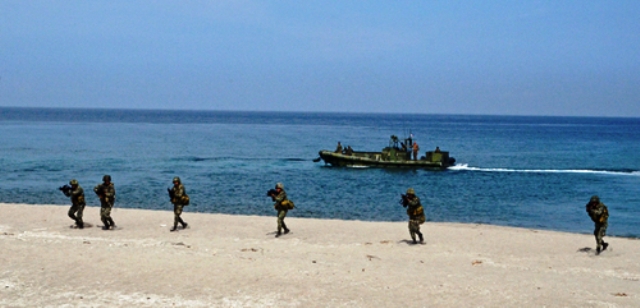![]() This week, the United States and the Philippine militaries – with enthusiastic support from Ferdinand Marcos Jr. – kick-started the implementation of the Enhanced Defense Cooperation Agreement (EDCA), the 2014 bilateral executive accord which had been delayed for eight years.
This week, the United States and the Philippine militaries – with enthusiastic support from Ferdinand Marcos Jr. – kick-started the implementation of the Enhanced Defense Cooperation Agreement (EDCA), the 2014 bilateral executive accord which had been delayed for eight years.
The EDCA enables the US to reestablish its strong military presence in the country – after being barred in 1991, when the Senate voted to end the almost 50-year stay of American military bases here.
Instead of the full-scale air and naval bases before, the EDCA allows the US to construct “military facilities” for their exclusive use inside those Philippine military bases they can choose. The Benigno Aquino III administration initially approved five bases – in Luzon, the Visayas and Mindanao – wherein the full construction of US military facilities, tagged as EDCA sites, is now being accelerated.
Last Feb. 4, during the visit by US Defense Secretary Lloyd Austin, Marcos Jr. approved four additional sites. Their locations will be formally announced soon, he said on Wednesday, adding that two of the four sites will be in the northern part of Luzon to “defend our eastern coast.”
His pronouncement incurred a heated reaction from China’s foreign ministry, which warned of escalating tensions in the Asia-Pacific region. Specifically, China accused the US of doing this by bolstering its military deployment in the region.
Last Monday, the US sent its Air Force Secretary, Frank Kendall III, to jumpstart the “repairs and updating” on the runway of Basa Air Base in Floridablanca, Pampanga. Kendall and acting Defense Secretary Carlito Galvez Jr. officiated at the ground-breaking rites.
Funded by the US at $25 million, the project’s aim is to make Basa “ideal for the efficient conduct of [US-Philippine] joint task force exercises and a natural hub for humanitarian assistance and disaster relief operations.” Basa is one of the five bases earlier chosen by the US and approved by the Philippine government.
Galvez remarked at this week’s event: “After almost eight years of delay and legal challenge, the EDCA implementation is now in full swing… We hope the (US) would consider more EDCA projects.”
Kendall said the strategic allies would “announce as soon as they can” the location of the four additional EDCA sites that Marcos Jr. had approved. Marcos Jr. reiterated Kendall’s statement, but deferred to the US as to the exact date for issuing a joint announcement.
Austin lost no time in calling Galvez, and the two defense chiefs spoke on the phone for “several hours,” noted one news report. After condemning China’s incursions on Pagasa Island in Palawan early this month, with Austin expressing particular concern over China’s swarming of more than 40 vessels around Pagasa, the duo discussed plans to conduct joint maritime activities in the South China Sea. They agreed to review the full range of maritime cooperation in their scheduled meetings, along with their foreign affairs counterparts, in Washington next month.
They also looked forward to holding the largest Balikatan joint military exercises from April 11 to 28, wherein 17,000-plus soldiers (12, 000 Americans and 5,000 Filipinos) will participate in live-firing drills. Besides the live-firing for the first time in the country of a Patriot missile, the US Army has announced the launching of Javelin missiles during the exercises. Both weapons systems have been provided to the Ukrainian military, which they used as defense against Russian air and ground attacks.
After Marcos Jr. confirmed that he had approved four new EDCA sites, including two in northern Luzon, China’s foreign ministry issued statements of opposition via their embassy in Manila.
“If the new sites are located in Cagayan and Isabela, which are close to Taiwan, does the US really intend to help the Philippines in disaster relief with these EDCA sites? And is it really in the national interest of the Philippines to get dragged by the US to interfere in the Taiwan question?” asked the Chinese statement.
And on the US claim – which the Marcos Jr. administration has readily echoed – that the US-funded EDCA site facilities would generate much-needed local jobs and boost the economy – another Chinese statement said with characteristic sarcasm:
“Creating economic opportunities and jobs through military cooperation is tantamount to quenching thirst with poison and gouging flesh to heal wounds. Such cooperation will seriously endanger regional peace and stability and drag the Philippines into the abyss of geopolitical strife and damage its economic development at the end of the day.”
As was his wont, Marcos Jr. seemed to let go unanswered the Chinese foreign ministry statements. When asked by a reporter about the previously expressed opposition by the governors of Cagayan and Isabela to US military presence in their provinces, he replied:
“We explained to them why it was important that we have that and why it will actually be good for their provinces.” He didn’t provide any details of the supposed benefits. He simply repeated what Galvez had claimed – that those who expressed objections had acceded “to support the idea of an EDCA site in their province.”
Now comes Cagayan Governor Manuel Mamba, saying it’s Marcos Jr.’s prerogative to decide where the EDCA sites should be allowed. However, he made clear, in an interview with the Associated Press, that he remained opposed to allowing the Americans to set up their military facilities in his province.
Why? Because Cagayan geographically sits across a sea border from southern China and Taiwan. Such a situation, he feared, could make his province a key target of China’s military should an armed conflict over Taiwan break out, which would involve US forces. (President Biden has repeatedly vowed to protect Taiwan if that happens.)
Mamba told AP: “It is the President’s call, not mine. But I maintain my stand against any foreign forces stationed in my province. Still, I am against EDCA sites in my province.”
Expanding the EDCA sites is an issue that continues to unfold. Moreover, we need to be vigilant about how the first five facilities would be used.
* * *
Email: [email protected]
Published in Philippine Star
March 25, 2023



